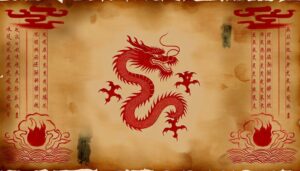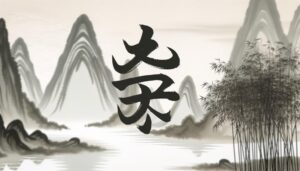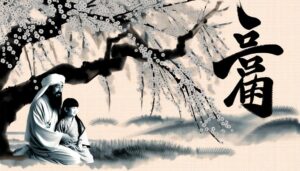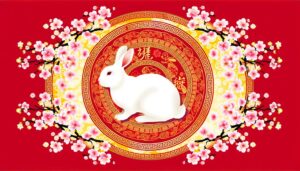What Is the Symbol for Peace in Chinese Culture?
In Chinese culture, the symbol for peace is 和 (hé), which signifies harmony and balance. This character combines 'grain' (禾) and 'mouth' (口), representing sustenance and effective communication, essential for societal equilibrium.
Historically, peace has been emphasized in Chinese philosophical texts and rituals, especially during the Zhou Dynasty. Influential philosophies, such as Confucianism and Taoism, stress the importance of ethical conduct, natural balance, and interconnectedness.
Through calligraphy and classical literature, the cultural narrative of peace is visually and textually expressed. Exploring these dimensions offers detailed insights into the rich tapestry of Chinese cultural heritage.

Key Takeaways
- The Chinese symbol for peace is represented by the character '和' (hé), which signifies harmony and balance.
- '和' combines the elements of 'grain' and 'mouth,' symbolizing sustenance and communication necessary for societal peace.
- Confucianism, Taoism, and Buddhism all contribute to the philosophical foundations of peace in Chinese culture.
- Peace in Chinese culture is visually expressed through calligraphy and traditional brushwork, embodying deep philosophical meanings.
- The symbol of peace in contemporary China influences socio-political policies and international perceptions, promoting unity and harmony.
Historical Origins
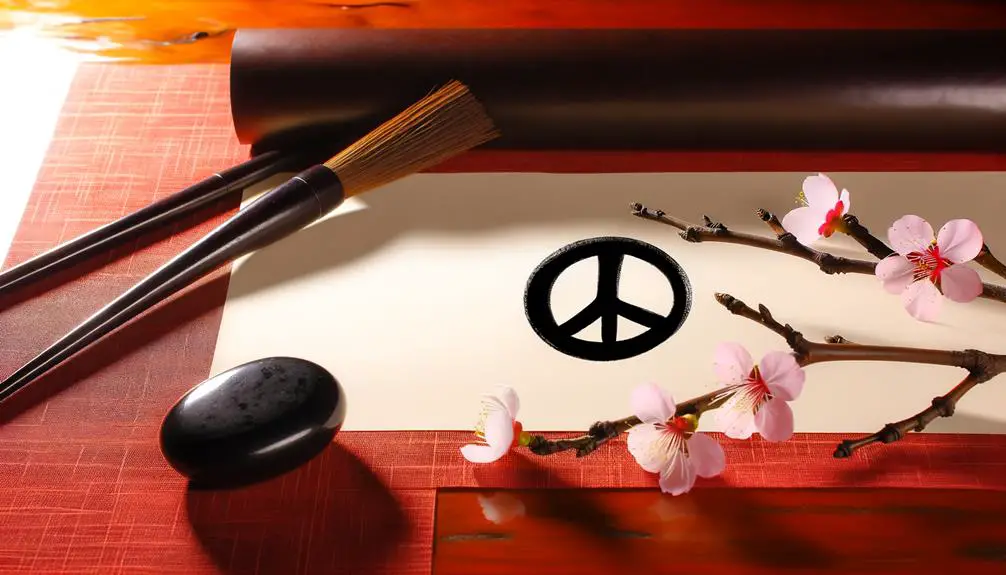
The historical origins of the symbol for peace in Chinese culture can be traced back to ancient philosophical texts and early dynastic rituals, reflecting the deep-seated value placed on harmony and societal balance.
The concept of peace, or '和' (hé), is deeply embedded in Confucian thought, where harmonious relationships are the cornerstone of societal stability. The Zhou Dynasty's ritual practices also emphasized peace through ceremonial music and rites aimed at fostering unity.
Ancient texts such as the 'I Ching' (Book of Changes) and 'Liji' (Book of Rites) underscore the importance of harmony in governance and personal conduct. These foundational ideas have profoundly influenced Chinese culture, underscoring peace as both a personal virtue and a societal imperative.
Etymology of 和
Building upon the historical significance of peace in Chinese culture, the etymology of '和' (hé) reveals a complex interplay of linguistic components that encapsulate notions of harmony and balance.
The character '和' combines the radical '禾' (hé), meaning grain, with '口' (kǒu), representing mouth. This synthesis symbolizes the importance of sustenance and communication in achieving societal equilibrium.
In ancient times, the availability of grain indicated prosperity and therefore peace, while the mouth signified discourse and mutual understanding. This dual representation underscores the Chinese belief that true peace arises from both material well-being and effective communication, reflecting a holistic view of societal harmony.
Consequently, '和' embodies the intricate relationship between sustenance, dialogue, and peace.
Philosophical Foundations
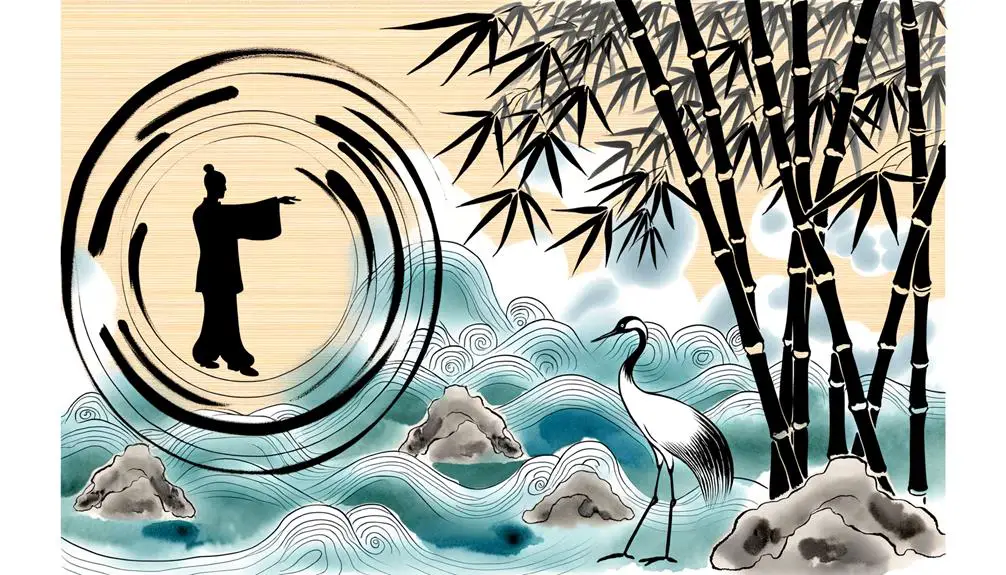
The philosophical underpinnings of the Chinese symbol for peace (和) are deeply rooted in the tenets of Confucianism, Taoism, and Buddhism.
Confucian principles emphasize societal harmony and the importance of ethical relationships, while Taoist ideals focus on the balance and natural order of the universe.
In contrast, Buddhist teachings advocate for inner tranquility and the alleviation of suffering through mindfulness and compassion.
Confucian Harmony Principles
Central to Confucian philosophy, the principles of harmony emphasize the importance of balance and proper conduct in fostering societal and interpersonal peace.
Confucius advocated for a hierarchical yet reciprocal system of relationships, where each individual fulfills their role with integrity and respect.
The concept of 'Li' (礼), or ritual propriety, underpins these harmonious interactions, ensuring that societal norms and moral duties are upheld.
Additionally, 'Ren' (仁), or humaneness, encourages empathy and compassion, further solidifying societal bonds.
Confucian harmony is not merely the absence of conflict but an active pursuit of ethical living and mutual respect.
This philosophical framework has profoundly influenced Chinese culture, promoting a vision of peace rooted in ethical behavior and communal responsibility.
Taoist Balance Ideals
In Taoist philosophy, the concept of balance is epitomized by the principle of 'Yin and Yang' (阴和阳), symbolizing the interconnected and interdependent nature of opposites in achieving harmony. This dualistic yet unified perspective underscores the intrinsic equilibrium inherent in the natural world and human existence. Yin represents attributes such as darkness, passivity, and femininity, while Yang signifies light, activity, and masculinity.
| Aspect | Yin (阴) | Yang (阳) |
|---|---|---|
| Nature | Passive | Active |
| Symbolizes | Darkness | Light |
| Gender | Feminine | Masculine |
| Element | Water | Fire |
| Season | Winter | Summer |
Buddhist Inner Peace
Within the domain of Buddhist philosophy, inner peace is attained through the cultivation of mindfulness and the understanding of the Four Noble Truths, which address the nature of suffering and the path towards its cessation.
The Four Noble Truths elucidate the existence of suffering (dukkha), its origin in attachment and desire (samudaya), the cessation of suffering (nirodha), and the path leading to this cessation (magga).
Mindfulness, or 'sati,' is integral to this journey, fostering a heightened awareness of the present moment and promoting detachment from transient desires.
This profound philosophical framework guides practitioners toward a state of equanimity and inner tranquility, embodying peace as both a personal and universal pursuit within the rich tapestry of Chinese Buddhist thought.
Peace in Confucianism
Confucianism, with its profound emphasis on social harmony and moral rectitude, offers a nuanced understanding of peace that extends beyond the mere absence of conflict. Central to Confucian thought is the concept of 'li' (礼), which denotes ritual propriety and respect for social hierarchies. By adhering to 'li', individuals cultivate personal virtue and relational harmony, fostering a stable, peaceful society.
Confucius advocated for 'ren' (仁), often translated as benevolence or humaneness, which underpins ethical interactions and mutual respect. Peace, as a result, is achieved through the internalization of moral values and the correct performance of societal roles.
This Confucian framework underscores the interconnectedness of personal virtue and collective well-being, portraying peace as a dynamic, ethical state grounded in communal responsibility.
Taoist Perspectives
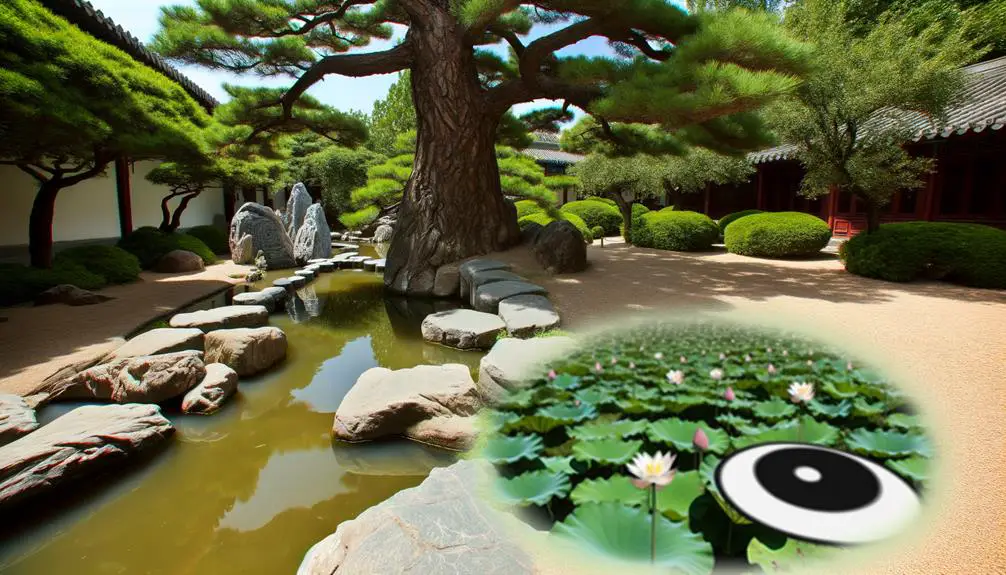
Taoist philosophy, with its emphasis on natural harmony and the unforced alignment with the Dao (道), offers a distinct yet complementary vision of peace.
In Taoism, peace is not an external state imposed by rules, but an intrinsic balance achieved through wu wei (無爲), or effortless action. This entails living in accordance with the natural order and understanding one's place within the cosmic flow.
The Daoist symbol of peace, 和 (hé), embodies the principle of harmony, suggesting that true tranquility arises from the integration of opposites and the seamless interaction of all elements.
Buddhist Interpretations
Buddhism envisions peace as an intrinsic state of enlightenment, achieved through the cultivation of mindfulness, compassion, and the cessation of suffering. This state, known as Nirvana, epitomizes ultimate tranquility and liberation from the cycles of rebirth.
In Chinese Buddhism, the character 和 (hé), symbolizing harmony, is often used to convey this peace. The teachings of the Buddha emphasize the Four Noble Truths and the Eightfold Path as the means to attain such peace. By adhering to these principles, practitioners seek to transcend personal and collective suffering, thereby fostering a harmonious existence.
The integration of these teachings into Chinese culture underscores a profound synthesis, wherein peace is as much a communal aspiration as it is an individual spiritual goal.
Artistic Representations
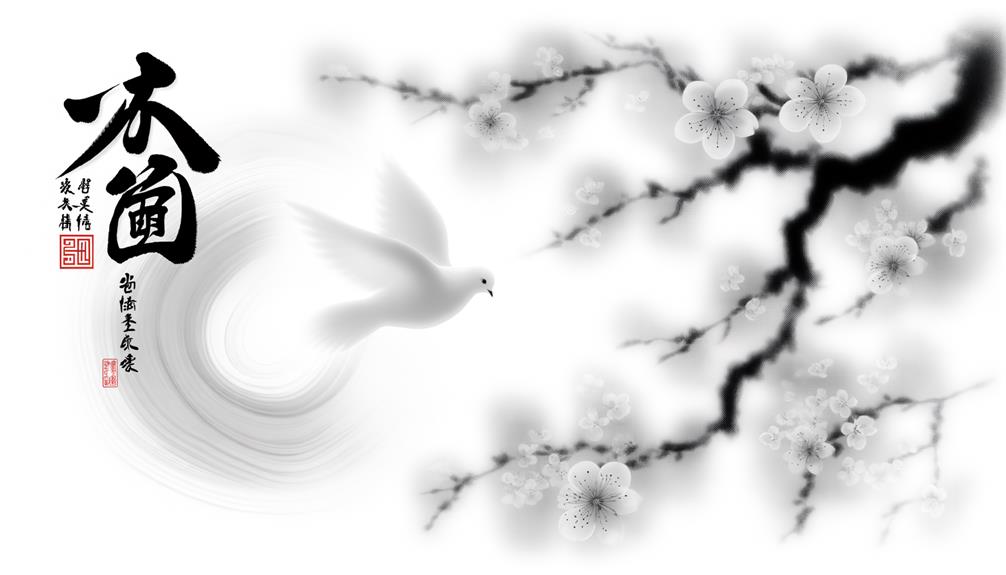
Artistic representations of peace in Chinese culture often incorporate traditional symbols and motifs that reflect the nation's rich philosophical and spiritual heritage.
The lotus flower, for example, symbolizes purity and tranquility, frequently appearing in paintings and sculptures.
Similarly, doves, universally recognized as symbols of peace, are often depicted in Chinese art, embodying notions of harmony and goodwill.
Dragons, revered as benevolent creatures, are also used, signifying protective peace and prosperity.
Moreover, the imagery of bamboo, known for its resilience and grace, represents peaceful strength.
These artistic elements are imbued with layers of meaning, resonating with Confucian, Taoist, and Buddhist principles, thereby offering a profound visual lexicon that underscores the cultural importance of peace in Chinese society.
Calligraphy and Symbolism
Building on the profound visual lexicon of peace in Chinese culture, calligraphy and its associated symbolism offer another layer of depth in conveying these ideals.
The character for peace, 和 (hé), is more than a mere symbol; it embodies a rich cultural narrative. Through the fluid strokes of traditional brushwork, calligraphy transforms 和 into an aesthetic experience, embodying harmony and balance.
Each brushstroke is laden with meaning, reflecting the philosophical underpinnings of Confucianism and Daoism, where peace is seen as an equilibrium of forces.
Besides, the placement and style of calligraphy in cultural artifacts—ranging from scrolls to architectural inscriptions—highlight its integral role in both personal expression and communal values, reinforcing peace as a cornerstone of Chinese ethos.
Peace in Chinese Literature
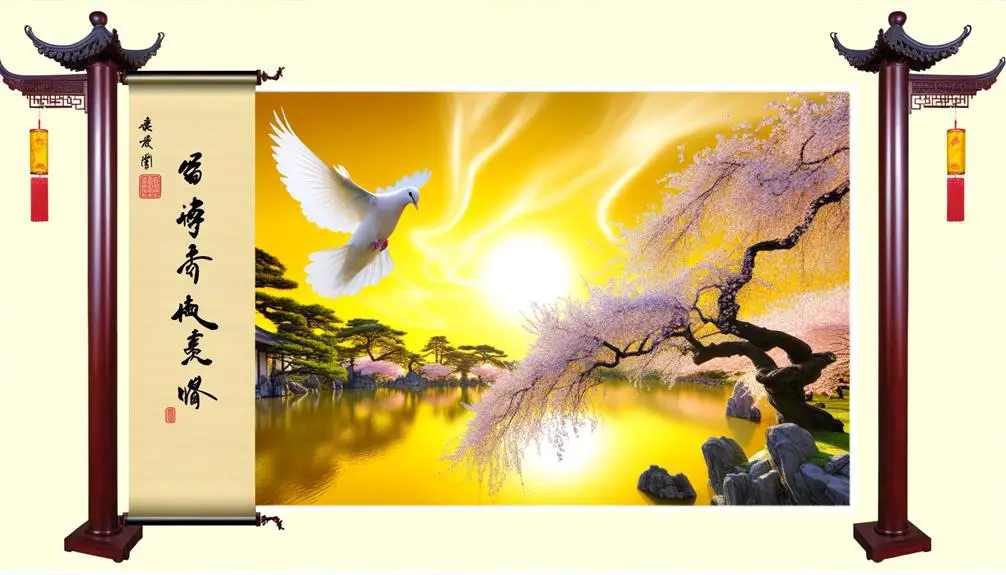
Throughout the annals of Chinese literature, the theme of peace is intricately woven into the fabric of classical poetry, philosophical treatises, and historical narratives, reflecting a deep-seated cultural reverence for harmony and tranquility.
Notable instances include:
- Confucian Texts: Emphasizing societal harmony through moral virtues and proper conduct.
- Daoist Literature: Advocating for inner peace and alignment with the Dao, or 'The Way'.
- Tang Dynasty Poetry: Celebrating the beauty of a peaceful natural world, as seen in the works of Li Bai and Du Fu.
- Historical Records: Chronicles such as Sima Qian's 'Records of the Grand Historian' depict the pursuit of peace in governance.
These literary works collectively underscore the importance of peace in shaping Chinese cultural and intellectual heritage.
Modern-Day Significance
In contemporary China, the symbol of peace remains a potent and multifaceted element, influencing socio-political discourse, international relations, and cultural expressions. Embodying centuries-old philosophical tenets, it is invoked in governmental policies and public diplomacy to project harmony and stability. This symbol permeates the arts, inspiring modern literature, visual arts, and cinema to engage with themes of unity and reconciliation. The following table illustrates the diverse modern-day significances of the peace symbol in China:
| Sector | Influence of Peace Symbol |
|---|---|
| Government Policies | Promotes internal harmony |
| Public Diplomacy | Enhances international image |
| Literature | Inspires contemporary narratives |
| Visual Arts | Reflects themes of unity and calm |
This enduring symbol continues to shape contemporary Chinese society profoundly.
Global Influence

The Chinese symbol of peace exerts a profound global influence, shaping international perceptions and contributing to cross-cultural dialogues on harmony and reconciliation. This influence is evident in several key aspects:
- Cultural Exchange: The symbol often features in international art exhibits, fostering mutual appreciation and understanding.
- Diplomatic Initiatives: It underscores peace treaties and diplomatic accords, symbolizing a universal desire for tranquility.
- Educational Programs: Universities worldwide incorporate the symbol in courses on Eastern philosophy and global peace studies.
- Commercial Use: Global brands utilize the symbol in marketing to evoke harmony and goodwill.
Through these avenues, the Chinese symbol of peace transcends cultural boundaries, promoting a collective ethos of global unity and understanding.
Conclusion
In sum, the Chinese symbol for peace, 和, is an epitome of cultural profundity, tracing its roots from ancient philosophies to modern-day significance. Its etymological and philosophical dimensions span Confucianism and Taoism, embodying harmony and balance.
The symbol's representation in calligraphy and literature underscores its timeless relevance. Indeed, 和 is not merely a character; it is the quintessence of peace, resonating through millennia and shaping global perceptions with unparalleled depth and resonance.



